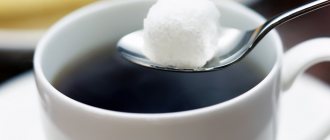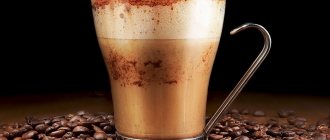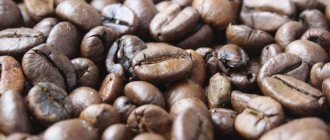The word “espresso” has two semantic translations: prepared under pressure, pressed, or fast. Each option is correct - such coffee is actually brewed under a certain pressure, the process of preparation, serving and drinking the drink does not take much time, which is quite important during the day.
Espresso is considered the most common type of coffee drink - most confidently believe that this is due to the ease of its preparation. Indeed, the classic recipe for espresso coffee does not seem complicated at first glance, but the popularity of the drink is not associated with this, but with a number of its other features, including a rich aroma, a bright, pronounced taste with a slight sourness, and the ability to provide an invigorating effect. impact.
Espresso coffee - the history of the drink
In Italy they love and appreciate strong black coffee made from good beans. Until the beginning of the 20th century, the favorite invigorating drink was prepared only in the Turks, which was not always practical, because you had to wait until it boiled. Imagine, if you are in a hurry and run into a coffee shop for a cup of strong coffee, you still have to wait until it is prepared and brewed for you.
This prompted one Milanese engineer-inventor, Luigi Bezzera, to create a machine that would make coffee itself. In 1901 he introduced his first coffee machine. Practicality, convenience and speed of preparation were appreciated. Almost immediately, the license for this invention was purchased by entrepreneur Desiderio Pavoni. After which he launched production and began producing the Pavoni coffee machine, which went on sale in 1905.
Coffee diet
This method of losing weight is widespread among women, but it is rightly called tough. Sitting on it for a long time is contraindicated. The optimal course is 3 days. Scientists have found that coffee can improve the activity of the body, as well as cleanse it of excess radicals. It's no secret that this drink is a strong diuretic. It is thanks to this property that all harmful substances are removed from the body, and with them extra pounds. The diet itself excludes absolutely all foods from the diet except dark chocolate and coffee. A person should drink up to 6 cups per day with an interval of two hours. You need to eat no more than 150 grams of chocolate
The calorie content of coffee depends on the additives, so it is important to exclude even sugar. This diet is contraindicated for people who have problems with the stomach and cardiovascular system.
How to choose coffee for espresso
The peculiarity and advantage of espresso coffee is its rich taste and aroma. This combination is produced only by Arabica beans, which are used in the preparation of espresso mixtures. If you use other varieties or only one Arabica variety, you will not be able to brew truly aromatic espresso. For this purpose, various mixtures are created.
To give the drink greater strength, some robusta beans are added to the mixture, which contains twice as much caffeine. Robusta also produces dense foam. This combination of Arabica and Robusta allows you to create coffee that is perfectly balanced in strength and taste.
IMPORTANT! If you buy coffee beans packaged in packages. Be sure to pay attention to the presence of a valve. It allows the grains to “breathe” and retain their original aroma throughout the entire shelf life.
The big advantage of buying in coffee shops is that you can choose the beans yourself and make your own mixture. The only thing to consider is that coffee by weight will retain its aroma and taste for no more than 10 days. Therefore, when you come home, pour it into a jar with an airtight lid. The same applies to ground coffee; after you open the pack, it is advisable to pour it into an airtight glass container. Do not store coffee in plastic containers!
Of course, the best taste and aroma of espresso coffee will be if it is made from beans that are ground just before preparation. Even in 2-3 hours, the crushed grains will lose some of their aromatic and taste qualities.
IMPORTANT! No beans or ground coffee with aromatic additives are used. They are not suitable for making espresso. A flavored drink prepared in an espresso coffee maker may not be of the best quality.
Try a light roast
The last thing to consider is the complete exclusion of additional products. By choosing higher quality, lighter roast coffee, you'll likely find that you don't miss the dairy or sugar.
Lighter roasts naturally contain more acids, resulting in more naturally sweet aromas, often reminiscent of fruit tea. We recommend trying our Ethiopian Yirgacheffe at least once to understand what other coffees can be.
Translation of an article from the Sip Coffee House website. Link to original.
Correct grinding of coffee for espresso
If you want to get delicious, aromatic, invigorating espresso coffee, you must meet a number of conditions. First, the beans must be fresh, as well as the grinding. The degree of grinding is also important - it should not be too coarse. At the same time, the grains cannot be ground “into dust”, as is done to make Turkish coffee. It is important to provide an intermediate, medium grind size that will allow the coffee to impart its aroma and taste, but at the same time will not “clog” the drink with grounds.
Here you need to take into account the cooking features:
- With very fine grinding, dust particles will simply clog the coffee maker filter; it’s worse if they get into the cup.
- Using coarsely ground beans will result in espresso that is tasteless and watery.
You need to buy coffee ground specifically for making this drink. This is a special fine grind of espresso, the grains are slightly larger than fine and finer than medium.
Espresso coffee - preparation secrets
The water temperature and pressure in the coffee machine (should be 88-96C and 9 atmospheres, respectively) are very important parameters. These parameters must be strictly maintained, otherwise the resulting coffee will not have a rich aroma and taste. Currently, you can find coffee machines on sale whose characteristics indicate a pressure of 15 and even 17 bar, but in this case we are talking about the operating pressure of the pump, and not the pressure in the preparation device (horn).
Of course, your coffee machine must be well-groomed, clean, and in full working order. Only in this case can you count on the espresso to be really good.
The technology for making espresso coffee does not seem very complicated. For one cup of coffee (40 ml of hot water), take 7 g of ground coffee (fresh grind only), these components are placed in appropriate containers. In this case, the coffee must be pressed into a special “tablet”. This is not difficult to do - the coffee powder is placed in the holder so as to completely fill it. To remove excess coffee, just a few gentle taps with a tamper (the small spatula that comes with most coffee machines) on the side of the holder are enough.
After this, the powder is pressed using a tamper - you need to press on it and turn the tamper a little (the so-called polishing of the tablet). You need to press on the tamper with a little force so that the tablet itself is quite dense. It’s easy to check whether a coffee tablet is prepared correctly - just turn the holder over, and if it doesn’t fall out of it and the powder doesn’t start to spill out, then everything is fine.
The coffee preparation time in a coffee machine takes about 25 seconds; it is not recommended to deviate from this figure by more than three seconds in either direction. This time is spent forcing heated water and steam under pressure through the coffee tablet. After passing through the powder, water, saturated with substances and elements given off by coffee, enters a cup that is preheated and placed on a special stand under the “spout” of the machine.
Classic espresso recipe
Using a coffee maker, classic espresso coffee is prepared. Now you will learn how to properly prepare a tasty, aromatic and invigorating drink.
Ingredients:
- Ground coffee – 7 g;
- Purified water – 30 ml;
- Granulated sugar - to taste.
Cooking technology
- Turn on the coffee maker and wait for the ready indicator to light up.
- 1 tbsp is poured into a coffee machine equipped with a coffee grinder. spoon of grains. To prepare in a carob coffee maker, add 2 teaspoons or 1 measuring container.
- Press the coffee using a tamper in a hodler.
- Place a holder in the coffee maker.
- Immediately place the cup for the finished drink. It cooks in 25 seconds.
- You can add sugar to taste.
The result should be a drink with a homogeneous, golden-nutty, but not too light foam (cream). It is the cream that is considered an indicator of the quality of coffee, and if its color can vary depending on the composition of the coffee mixture, then the thickness of the foam in any case should not be less than 2 mm, and the density should be such that in the first minutes after preparation, breaks in the foam (formed during stirring coffee with a spoon, for example) take a drag.
How to make Espresso in Turkey
The traditional method of preparation involves using a carob coffee maker, but what to do if you don’t have one. The question arises - how can you brew espresso coffee in a Turk?
I’ll say a few words about espresso – a method of preparation where water passes under pressure through a layer of ground beans. At the same time, it absorbs all the taste, aroma and beneficial properties of natural raw materials.
The classic version uses 8-10 grams of ground coffee and 30 ml of water. The result is a strong, invigorating drink with a pleasant creamy foam on the surface. You can prepare it at home by brewing espresso in a Turk. We will tell you how to do this now.
To prepare it we will need:
- Ground coffee (fine grind) – 2 tsp;
- Bottled water – 50 ml;
- Add sugar to taste.
How to cook
- Pour ground coffee into a clean, dry coffee pot and heat over the fire for 15 seconds. If you drink a drink with sugar, add it immediately before adding water. Heating will help to get a more pronounced taste and aroma.
- Next, pour in lukewarm water (not cold!). Over low heat, bring the coffee until the foam begins to form and immediately remove from the stove. Then return the Turk to the fire and let it boil a second time until the foam rises.
- Taking the cezve aside, wait a minute to let it settle and pour it into a small coffee cup. Espresso coffee brewed in a Turk is ready!
It turns out tasty, aromatic and strong, but still differs from the classic one prepared in a coffee maker.
How to serve and drink espresso
The drink is poured into special small coffee cups or thick-walled cups. The barista must serve a glass of clean water along with the drink. Before you start drinking classic espresso, you need to take a sip of water to cleanse your taste buds and fully experience the taste of natural, freshly brewed coffee.
Finally, another feature of espresso coffee is that the drink must be served within 1-1.5 minutes after preparation - it is believed that only in this case does the coffee have a chance of reaching the guest “alive”, fully retaining its taste and aroma.
Juice
| Product | Squirrels | Fats | Carbohydrates | Kcal per 100 g. |
| apricot | 0.5 | 12.7 | 55 | |
| quince | 0.5 | 0.1 | 11.2 | 51 |
| pineapple | 0.4 | 0.2 | 11.5 | 46.5 |
| orange | 0.7 | 0.1 | 13.2 | 60 |
| watermelon | 0.6 | 0.1 | 5.8 | 38 |
| banana | 12 | 48 | ||
| birch | 2 | 8 | ||
| elder | 1.1 | 0.2 | 5.1 | 27 |
| grape | 0.3 | 0.2 | 16.3 | 70 |
| cherry | 0.7 | 0.2 | 11.4 | 51 |
| pomegranate | 0.3 | 0.1 | 14.2 | 56 |
| grapefruit | 0.3 | 0.1 | 7.9 | 38 |
| pear | 0.4 | 0.3 | 11 | 45.5 |
| guava | 0.09 | 0.06 | 13.87 | 57 |
| blackberry | 0.3 | 0.6 | 7.8 | 38 |
| strawberry | 10 | 41 | ||
| cabbage | 1.8 | 0.1 | 4.7 | 25 |
| potato | 2 | 0.4 | 16.3 | 77 |
| kiwi | 0.3 | 11 | 40 | |
| strawberry | 0.6 | 0.4 | 7 | 29.9 |
| cranberry | 0.4 | 0.3 | 11 | 45.5 |
| gooseberry | 0.7 | 0.2 | 9.1 | 45 |
| lime | 0.38 | 8.23 | 25 | |
| citric | 0.6 | 3.9 | 33 | |
| crimson | 0.75 | 24.7 | 100 | |
| mango | 13.5 | 54 | ||
| tangerine | 0.8 | 0.3 | 8.1 | 36 |
| passion fruit | 0.7 | 0.2 | 4.5 | 23.2 |
| carrot | 1.1 | 0.1 | 12.6 | 56 |
| multifruit | 12 | 48 | ||
| nectarine | 0.4 | 8.6 | 37 | |
| noni | 0.1 | 0.3 | 10 | 44 |
| sea buckthorn | 2.2 | 5.7 | 4.5 | 60 |
| vegetable | 0.82 | 3.32 | 20 | |
| cucumber | 0.8 | 0.1 | 2.5 | 14 |
| papaya | 0.39 | 0.05 | 13.4 | 51 |
| peach | 0.9 | 0.1 | 9.5 | 40 |
| parsley | 3.7 | 0.4 | 7.6 | 49 |
| fruit and berry | 11.7 | 47 | ||
| radish | 1.9 | 0.2 | 6.7 | 36 |
| rowan | 0.1 | 0.1 | 11.4 | 50 |
| beetroot | 1 | 9.9 | 42 | |
| celery | 0.65 | 0.25 | 4.75 | 31 |
| plum | 0.3 | 0.1 | 15.2 | 68 |
| tomato | 1 | 0.1 | 2.9 | 18 |
| pumpkin | 9 | 37.5 | ||
| black currant | 0.5 | 7.3 | 41 | |
| bilberry | 1.8 | 12 | 47 | |
| apple | 0.5 | 0.1 | 10.1 | 46 |
The benefits and harms of espresso
Drinking a cup of coffee, we feel a surge of strength and energy, our mood improves. The drink produces this effect due to the caffeine content in it. Espresso stands out for its invigorating effect, but in addition it has a lot of other health benefits.
Let's look at all the advantages of drinking this strong, tasty coffee, and also in what cases it is contraindicated.
Improves brain function. The study clearly showed that drinking two cups of espresso during the day has a positive effect on brain activity. Alkaloids and caffeine activate blood circulation and the transmission of nerve impulses, thereby increasing concentration and the ability to absorb more information.
Good for weight loss. An important difference between espresso coffee and drinks with additives is its low calorie content. At the same time, it speeds up metabolism and promotes the burning of subcutaneous fat. But only if you don't add cream and sugar or eat it with a couple of large cakes
Helps prevent stroke. Leading Swedish scientists conducted a study for 10 years that included men and women aged 35-50 years. As a result, it was found that drinking even one cup of classic espresso per day reduces the risk of stroke by 25%. This effect is explained by the content of antioxidants in the natural product.
Reduces the risk of developing diabetes. The results of studies have proven that one or two cups of natural strong coffee prevents the risk of developing type 2 diabetes.
Despite all the benefits, espresso coffee has contraindications. People with hypertension should drink it with caution, because caffeine can cause surges in blood pressure. Coffee can be harmful if you drink it on an empty stomach, as well as if you have peptic ulcers and gastritis.
How many calories in a cup of espresso
The natural drink contains many useful substances and microelements, antioxidants and acids. At the same time, the calorie content of espresso coffee without sugar is only 2 calories per 100 ml of drink. When sugar, milk or cream is added, the calorie content also increases.
For example, 1 teaspoon of sugar or 5 g stick contains 20 kcal. This means that 100 ml of espresso with sugar contains 22 Kcal. And if you add two spoons, then 42 calories.
How many calories are in a cup of espresso with milk?
Cream and milk are considered high-calorie foods, but this recipe uses a little of them, usually 1 tbsp. – 20 ml is approximately 12 Kcal. By adding this amount of milk to a small shot of espresso, its nutritional value increases, but not enough to affect your figure.
You can safely sweeten the drink with a spoonful of sugar and add a little milk. Espresso with sugar and milk contains on average 30-32 kilocalories.
Types of cappuccino
Cappuccino (the calorie content of a sugar-free drink depends on the fat content of the added milk component) initially contained 1 part espresso (30 ml), 2 parts milk, with the inclusion of milk foam (60 ml). Coffee lovers improved the recipe by preparing cappuccino from 60 ml of espresso and the same amount of milk. The surface of the drink is decorated with a pattern and sprinkled with cinnamon, ginger, and ground chocolate.
Depending on the method of preparation and additives they differ:
- Black cappuccino. Consists of black coffee with the addition of milk foam or cream.
- White. More similar to a latte and consists of adding espresso to the creamy part.
- A cold drink made by whisking and combining cold espresso, milk and foam.
- Iced cappuccino. Prepared from chilled ingredients with the addition of ice cubes.
- Dry. The strongest option, requiring mixing cream and espresso in equal proportions.
- Chiaro. A milk cappuccino containing a minimal amount of coffee and a large amount of milk, heated to a very high temperature and less frothed.
- Starbucks. Diet cappuccino made from skim milk. This serving contains only 20 kcal. The foam for the drink is very loose.
- Latte cappuccino. A layered version of a coffee-milk mixture, in which espresso is placed at the very bottom, milk foam is placed second, and whipped cream completes the composition.
- Chocolate, nutty, caramel. It is obtained by adding syrup with a certain taste and chocolate or nut crumbs.
- Milk whipped with decaffeinated syrup.
How much espresso can you drink per day?
The last and most important question is how many cups of espresso can you drink per day? In this case, it all depends on the size of the portions: regular or double.
If you prefer the classic version of an invigorating drink, 30 ml, then the norm is 2-3 cups per day. But not more! For those who love doppio, drinking one cup in the morning is enough. The instant version of the drink is, of course, not quite espresso, but it is popular for its speed of preparation. Instant granules contain more caffeine, so it's best not to exceed two cups throughout the day.
Helpful advice! If you like to cheer up during the day with your favorite drink, then it is recommended to drink espresso coffee made from pure Arabica, without Robusta. After all, it is the Robusta variety that has the highest caffeine content, which has an invigorating effect, but its excess can negatively affect your well-being.
Beneficial features
Cocoa benefits the cardiovascular system, tones and helps fight stress, invigorates in the morning and improves metabolism. Zinc, which this product is rich in, is involved in the creation of the structure of DNA and RNA, in the synthesis of proteins, and in the production of vital enzymes. For adolescents, this element is necessary for the normal course of puberty. Due to the high iron content, cocoa powder has a positive effect on the process of hematopoiesis. There is evidence that it even prevents the risk of developing cancer.
Healthy heart and blood vessels
It has been proven that cocoa strengthens vascular walls and increases their elasticity. As a result, the risk of blood clots is reduced by 70%. Also, research results confirm that with regular use of the product, the likelihood of developing cardiovascular diseases decreases by 50%. This effect is due to epicatechin, which also improves short-term memory.
The benefit of exotic bean powder is that it lowers blood pressure by stimulating cerebral circulation. By receiving more oxygen, the brain begins to work better. Therefore, cocoa powder should be included in the diet of mental workers. It also benefits people with weak brain vessels.











